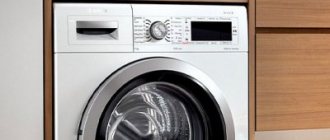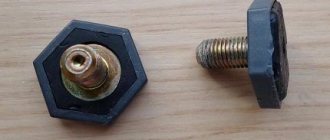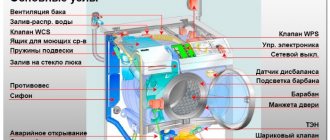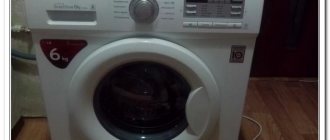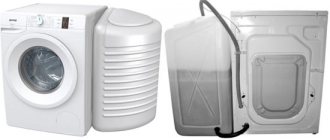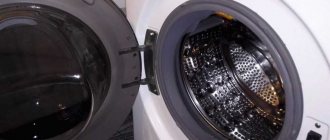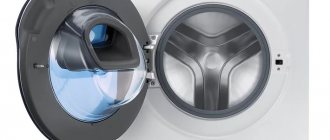Installing a washing machine (WM) in the kitchen is often a necessary measure, because... there was simply no room for it in the small bathroom. And sometimes such an arrangement is a deliberate step, if it is convenient to place all the equipment in a house or apartment in one place.
There were other advantages
:
- additional work surface. As a rule, SM is installed under a countertop on which you can cook;
- a small bathroom without a machine will become free and convenient to use.
Washing machine in the kitchen, built into the end of the kitchen unit
. Of the minuses:
- the need for camouflage (especially in kitchens with a classic design, where SM does not fit at all);
- proximity of washing powder to food;
- the need to carry dirty laundry to the kitchen every time you wash;
- the need to select and prepare a place for installation in advance.
Kitchen with built-in SM under the countertop
Despite all the listed inconveniences, the housewife will eventually get used to this arrangement. Important questions remain: how to integrate a washing machine into a kitchen unit so that it does not violate the stylistic unity, and its use is comfortable. We'll talk about this in more detail later.
Advantages and disadvantages
The pros and cons of a washing machine in the kitchen should be taken into account when moving it.
| Advantages | Flaws |
|
|
Consumer Reviews
Users on many forums are actively discussing the topic of the proximity of the PMM to the oven. The majority of respondents claim that placing built-in equipment in the neighborhood is completely safe. Thanks to the partition of the pencil case, the equipment is protected from troubles.
Expert commentary. If the stove is turned on at the same time, it can cause a short circuit in the electronic unit of the dishwasher.
Users who have built-in appliances located nearby are not advised to turn them on at the same time. Others argue that simultaneous activation depends on the wiring and power supplied to the house. Each device must have a separate electrical wire to the panel and a separate fuse.
It is not advisable to place the dishwasher near, above or below the oven. If you have to allow close proximity, it is necessary to ensure maximum thermal insulation of the devices and maintain a minimum technical gap.
Where is the best place to place the machine?
The main requirements for installing a washing machine are: proximity to communications (water supply and sewerage), the presence of a grounded outlet and a flat floor surface.
The photo shows a washing machine and dishwasher at the sink
To avoid regretting the transfer, follow the rules:
- do not allow the washing machine to be close to other household appliances: vibration is harmful to the refrigerator and oven;
- Never install the machine under the hob - high temperatures will damage its plastic parts;
- placing a washing machine and a dishwasher next to each other is possible if there is a gap between them and vibration during spinning will not be transmitted to the dishwasher;
- water and sewer hoses should be no more than 2.5-3 meters in length, this will reduce the possibility of leaks and blockages in them;
- when placing the washing machine inside the box, it is necessary to leave a gap of 2 cm on each side to take into account vibration;
- take care to install a base that is easy to remove so that you can get to the drain filter if necessary.
Optimal clearance
Not only can a washing machine harm the stove, the opposite can also happen. Everyone knows that even today some apartments have old-style electric and gas stoves installed, that is, they were produced in Soviet times and, accordingly, are less advanced.
So, old models tend to heat up the walls greatly. If it comes into contact with the plastic elements of the washer’s body, this can cause serious damage, because old plates can heat up to 90-95 degrees, and this is too high a temperature for plastic. Thus, the washing machine will quickly fail.
Installation methods
The choice depends on the design of the kitchen for the washing machine, the model and preferences of each family. A built-in washing machine in the kitchen will remain invisible to prying eyes; the classic side-loading version can be hidden under the facade or made an accent; a vertical-loading machine requires a separate space, but there is an option to install it under the countertop.
Built-in washing machine in the kitchen under the countertop without a door
A conventional machine is installed in an empty niche between the modules. You don’t need to order a special box for it, but you should take care of harmony in the interior in advance. To keep the look unobtrusive, choose a model that matches the color and style of other appliances or kitchen cabinetry that is nice to display.
Dimensions are no less important than design: a successful model is considered to be 2-3 cm below the tabletop and narrower than the niche by 5-6 cm. Calculate the depth so that there is space for connection.
Due to the need for gaps on the sides, the cracks will always be visible: to avoid this, choose another option.
The photo shows a dark kitchen with black appliances
Washing machine built into the kitchen unit behind the facade
The range of built-in models is small, and their price is quite high, but at the same time the built-in washing machine is almost invisible in the kitchen.
The stationary model can also be hidden behind the door. The requirements for dimensions and clearances in this case are the same as for installation without a door. But in this case, depth is also important: there should be room at the back for a hose with water, and at the front for installing the facade, taking into account a gap of 2.5 cm.
Tip: loading and unloading laundry is more comfortable when the door opens 110 degrees or more.
In the photo on the left is an option for placing the machine on the end
Stationary location
Options for kitchens with a washing machine are not limited to built-in ones.
In a spacious kitchen or studio, you can equip a special laundry area, separating it with a curtain or door. A narrow model installed at the end of the kitchen unit will save space in a small kitchen.
In the photo there is a dedicated laundry closet
Washing machine in the closet
There are several options for implementing this idea:
- Kitchen cabinet with hinged doors. If you make it 20-25 cm wider than necessary, you can organize the storage of detergents.
- Bottom sector of the pencil case. Any model will fit into the custom cabinet, and there will be free space on top for everything you need.
- Built-in wardrobe. Close the free niche with doors and you can get a spacious space for placing a washing area.
Tip: leave a gap on the left so that nothing interferes with the extension of the tray for powder and conditioner.
The photo shows an option for storing laundry detergents
Placing built-in appliances in the kitchen: where is the hood?
Plan the location of built-in appliances in the kitchen so that during the installation process is observed , from the bottom edge of the hood to the hob:
- gas stove - at least 750 mm
- electric stove - at least 650 mm
- induction - not less than 500 mm
The instruction manual provides this information.
Placement of a top-loading machine
A similar model can be placed permanently, built under a folding tabletop, or put away in a closet.
In the first case, the appearance of the device may negatively affect the interior; in the second, it will not always be convenient to use. When located in a closet, it is necessary to leave space on top for comfortable loading and unloading.
The photo shows a built-in top-loading machine
Sockets built into the tabletop
Of course, built-in sockets are stylish and functional, but not practical! Because over time they clog and leak. And the tabletop must be solid and waterproof. Therefore, it is recommended to use regular wall sockets .
Be sure to install sockets not behind the equipment itself, but above, below, to the right or to the left of its location. This way you can easily and quickly turn off the device. Provide wall sockets in the window sill slopes. The window sill is an excellent parking area for all small household appliances!
Options for different layouts
A corner kitchen with a washing machine is the most common option, in which the machine can be placed near the sink, at the end of the unit or under the window.
In a direct kitchen, it is installed closer to the sink to accommodate the rest of the equipment or built into a pencil case.
In the photo on the right is a corner kitchen with washing appliances
A two-row kitchen set provides more opportunities for comfortable placement of all necessary appliances: the sink, washing machine and dishwasher are placed on one side, creating a compact “wet zone”, everything else is on the other.
The location for installing a washing machine in a U-shaped kitchen depends on the dimensions and layout. You should not install it further than 3 meters from the pipe outlet.
In the photo there is a washing area in a large kitchen
In the photo on the left is a silver machine in a loft-style kitchen
Connection to water supply
If you can connect the drain from the equipment either directly to the sewer or using a siphon, then there are several options for connecting water:
Crimp coupling for connecting metal pipes. A hole for connection is created in the pipe, a coupling is placed on the pipe, and a ball valve with a 3/4 threaded outlet is placed on it. An inlet hose is connected to the outlet.
Crimp coupling for connection to metal-plastic pipes. After cutting into the pipe, the fitting is connected. The connections are sealed. A tap is connected to the fitting, and a filling pipe is connected to it.
Tee when connected through a sink faucet. At the junction of the water supply lines and the mixer hose, a tee is screwed in, to which the pipe from the machine is connected.
Tee if there is a water outlet in the wall. The equipment is connected to it directly through a tap.
Location features for a small kitchen
In Khrushchev, where there is often not enough work space, the washing machine should be placed under the work area. The washing machine in a small kitchen is covered with a facade or placed openly - the main thing is that it fits in size.
The photo shows the placement of the washing machine next to the sink
In a corner kitchen set, it is convenient to place the machine near the sink on the other side of the stove and oven. The linear layout also suggests a place for the washing machine at the sink, separated by a section from the hob.
Do not place electrical appliances or other items on the countertop above the washing machine; they may fall and be damaged due to vibration.
Where to install the oven?
It is placed both under the hob and in a column at chest or waist . This design of the oven is convenient - you don’t have to constantly bend over and is safe for children. They cannot reach heated surfaces.
For trouble-free operation of the built-in oven in confined spaces, engineers had to improve it:
- have provided a more powerful air exchange system, which prevents the body in which the cabinet is built from heating up
- Improved thermal insulation, which also prevents heat from spreading outside the oven
